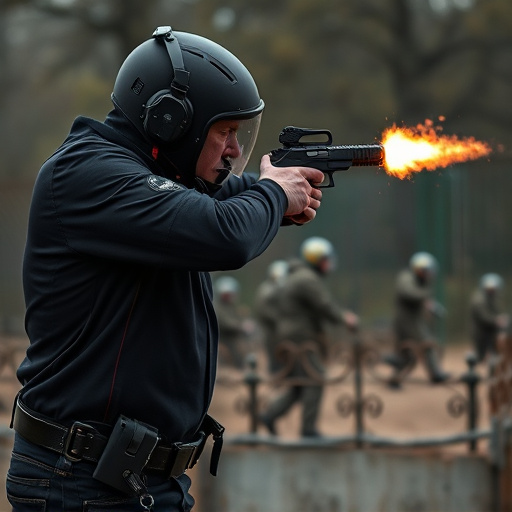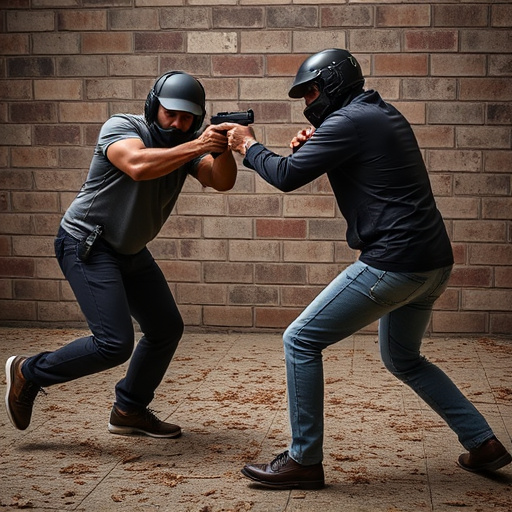Paralysis Duration: Exploring Taser Impact & Safety Features for Beginners
Stun guns with safety features, designed specifically for beginners, offer a non-lethal self-defense…….
Stun guns with safety features, designed specifically for beginners, offer a non-lethal self-defense option. These devices use electric shocks to temporarily disable targets, with adjustable voltage settings and automated triggers minimizing risks. The stun duration varies based on models, target attributes, and environmental conditions, averaging 2-5 seconds but potentially longer. Modern stun guns come with trigger locks and smart chips for safety, emphasizing responsible use through training, understanding legal guidelines, and recognizing side effects like muscle pain.
“The impact of taser deployment and its subsequent paralysis duration is a critical yet often overlooked aspect of law enforcement and self-defense. This article delves into the factors influencing the length of paralysis caused by stun guns, focusing on the role of taser technology and safety features designed for novice users. We explore how various elements contribute to paralysis duration, emphasizing the importance of understanding these dynamics. Additionally, we cover training guidelines, legal implications, and the latest advancements in stun guns with integrated safety mechanisms, providing insights crucial for both professionals and beginners.”
- Understanding Taser Deployment and Its Impact
- Factors Influencing Paralysis Duration
- Safety Features in Stun Guns for Beginners
- Assessing the Risk of Long-Term Effects
- Training and Best Practices for Safe Use
- Legal Considerations and Liability Risks
Understanding Taser Deployment and Its Impact

Tasers, also known as stun guns, are non-lethal weapons designed to temporarily incapacitate a person by delivering an electric shock through specialized probes connected to high-voltage cables. When deployed, these devices discharge a stream of electricity that disrupts muscle control in the target’s body, leading to temporary paralysis and disorientation. The impact of a Taser can vary depending on factors such as range, proximity of probes to vital areas, and individual physical attributes.
For beginners or those interested in self-defense options with built-in safety features, understanding how Tasers work and their effects is crucial. Modern stun guns often come equipped with safety mechanisms like automated deployment triggers, which ensure the device fires only when activated, minimizing the risk of accidental discharge. Moreover, some models offer adjustable output levels, allowing users to choose a setting that balances effectiveness with safety considerations. Such features make Tasers appealing as personal protection tools, providing individuals with peace of mind while learning to navigate potentially dangerous situations effectively.
Factors Influencing Paralysis Duration

The duration of paralysis induced by a Taser, or stun gun, can vary greatly and is influenced by several factors. One key factor is the model and design of the weapon; newer stun guns with safety features for beginners often have lower volt settings, which may result in shorter durations of immobilization. The electrical current’s intensity and delivery also play a significant role—higher voltage can extend the paralysis period. Additionally, the target’s physical attributes, such as body size, muscle mass, and overall fitness level, can impact how long they remain paralyzed.
The environment and external conditions are another set of considerations. For instance, cold temperatures might increase the duration of paralysis due to reduced blood flow. Conversely, hot environments could potentially reduce the effect due to increased sweat, which acts as a conductor. The target’s posture after being stunned can also affect the recovery time; certain positions may limit circulation and extend the immobilization period.
Safety Features in Stun Guns for Beginners

Stun guns, also known as electroshock weapons, are designed to immobilize targets using an electric current. For beginners considering a stun gun for self-defense, understanding safety features is paramount. Many modern stun guns come equipped with several built-in safeguards to minimize the risk of accidental deployment and unauthorized use. These safety features often include trigger locks, which prevent the weapon from firing unless the trigger is intentionally pulled, ensuring it’s not activated by accident or jostling. Some models also incorporate smart chips that detect body movement and temperature, only activating the stun when a living target is within reach, thereby reducing harm to inanimate objects or animals.
Additionally, stun guns with safety features often have adjustable intensity settings, allowing users to choose the level of force necessary for a specific situation. This feature is crucial as it enables beginners to familiarize themselves with their weapon’s capabilities while adhering to legal restrictions on stun gun use. User-friendly controls and clear instructions further enhance safety by ensuring proper handling and preventing misuse.
Assessing the Risk of Long-Term Effects

When considering stun guns with safety features for beginners, it’s crucial to understand that the duration of paralysis from a taser deployment can vary significantly. Studies suggest that the average immobilization time is around 2-5 seconds, but this can extend much longer in certain cases. Assessing the risk of long-term effects involves considering both the manufacturer’s data and independent research. Many modern stun guns market themselves as having safety features to reduce the risk of prolonged paralysis, which is particularly important for users who may have underlying health conditions or are concerned about potential consequences.
However, it’s essential to remember that these devices still deliver a powerful electrical shock. Prolonged exposure can lead to muscle pain, headaches, and in rare cases, more severe reactions. Beginners should be educated on the limitations and potential side effects of stun gun deployment. Understanding the risks associated with longer-lasting paralysis allows users to make informed decisions about when and how to use their stun guns effectively while minimizing adverse outcomes.
Training and Best Practices for Safe Use

Training and best practices are paramount when considering the safe use of stun guns with safety features, especially for beginners. Many modern stun devices come equipped with safety mechanisms to prevent accidental deployment and minimize the risk of excessive force. These tools should only be used as a last resort, and proper training is essential to ensure their effective and responsible utilization.
Beginners should start by learning the basic mechanics of the device, including trigger activation and deactivation procedures. Understanding the range and duration of paralysis induced by the stun gun is crucial. Proper training also involves recognizing when and how to deploy the weapon legally and ethically, ensuring that all uses are in compliance with local laws and regulations.
Legal Considerations and Liability Risks

When discussing the effects and implications of taser deployment, it’s crucial to consider the legal landscape surrounding their use. The duration of paralysis induced by stun guns can have significant legal ramifications, especially when considering self-defense scenarios or interactions with law enforcement. Each jurisdiction has its own set of rules dictating when and how these devices can be employed, with many focusing on ensuring minimal harm and proportionality in their application.
For beginners exploring stun guns with safety features, understanding the potential liability risks is essential. Proper training and adherence to legal guidelines are paramount to avoid legal repercussions. These considerations include not only the duration of physical paralysis but also the aftermath, such as any lasting effects or complications that may arise from the use of such devices.
In conclusion, taser deployment can lead to paralysis, with duration varying based on several factors. Understanding these factors, such as the stun gun’s voltage and pulse width, is crucial for minimizing risks, especially during situations where individuals may have limited mobility or medical conditions. Utilizing stun guns with safety features designed for beginners and adhering to best practices and legal considerations can help ensure their effectiveness as personal safety tools while mitigating potential long-term effects. For those new to these devices, prioritizing education and responsible handling is key to making informed decisions in high-stress scenarios.


